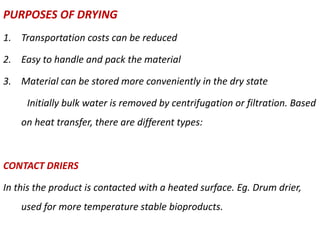The document discusses downstream processing techniques used to recover and purify products from fermentation processes. It covers various unit operations used such as filtration, flocculation, and centrifugation. Filtration techniques discussed include batch filters like plate and frame filters and pressure leaf filters. Continuous filters described are rotary vacuum filters. Cross-flow filtration is also mentioned. The goal of downstream processing is to separate and purify metabolites of interest from fermentation broth in an efficient manner.











![TYPES OF FILTERS
A. BATCH FILTERS
1. Plate and frame filters: A plate and frame filter is a pressure filter in
which the simplest form consists of plates and frames arranged
alternatively. The plates are covered with filter cloths or filter pads .
The plates and frames are arranged on a horizontal framework and
held together by means of a hand screw or hydraulic ram so that
there is no leakage between the plates and frames. [ so a series of
liquid tight compartment are formed]
The slurry is fed to the filter frame through the continuous channel
formed by the holes in the corners of the plates and frames.](https://image.slidesharecdn.com/unitii-1-230917144124-fa281035/85/Unit-II-1-pptx-12-320.jpg)









![CROSS- FLOW FILTRATION [ TANGENTIAL FILTRATION ]
In this process, the feed stream flows parallel to the membrane face.
Applied pressure causes one portion of the flow stream to pass through
the membrane ( filtrate)while the remainder ( retentate) is recirculated
back to the back to the feed reservior. The benefits of cross- flow
filtration are: A) efficient seperation, B) closed system C) seperation is
independent of cell & media densities D) lower rate of the blockage of
the membrane so that filter aids are not necessary.](https://image.slidesharecdn.com/unitii-1-230917144124-fa281035/85/Unit-II-1-pptx-22-320.jpg)















































